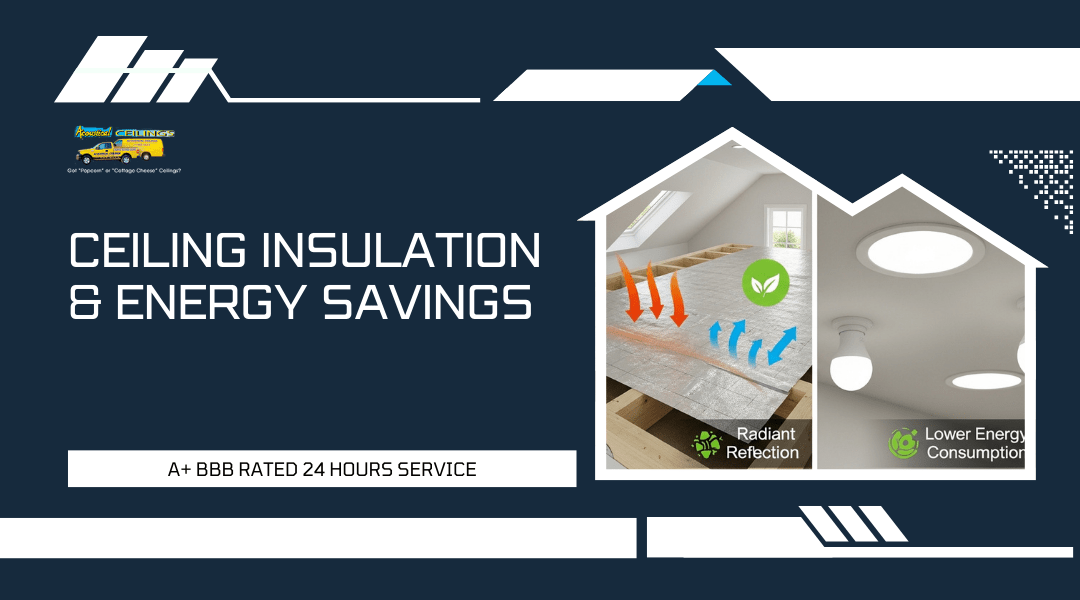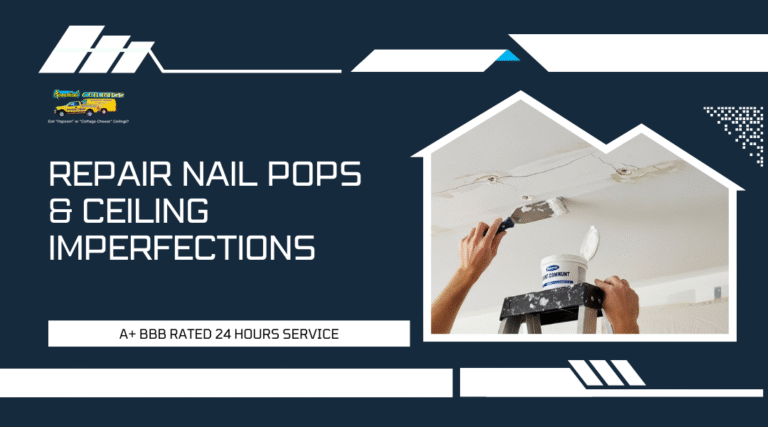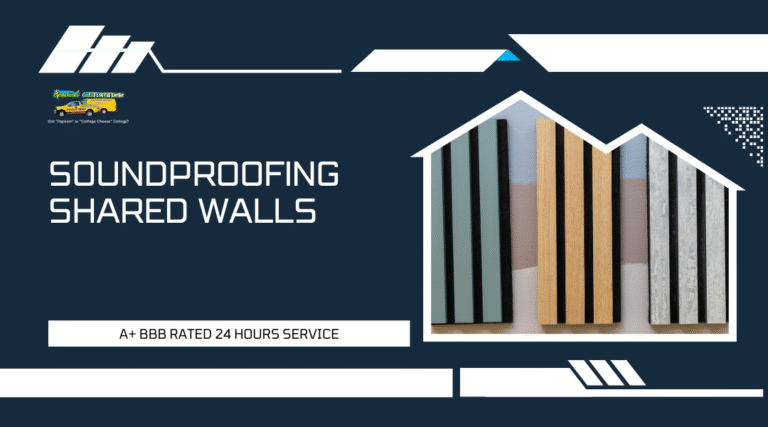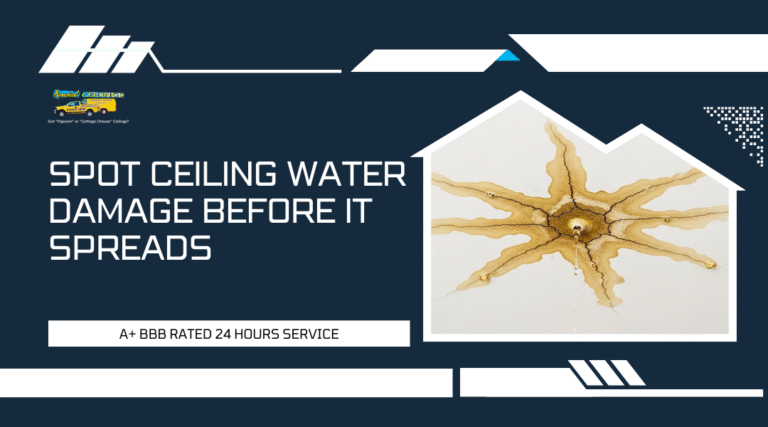Ceiling insulation plays a direct role in how much you spend on heating and cooling each month. Proper insulation reduces energy loss, lowers utility bills, and helps keep indoor temperatures consistent year-round. Without it, conditioned air escapes through the ceiling, forcing your HVAC system to work harder and driving costs higher.
You’ll also notice the difference in comfort. A well-insulated ceiling prevents hot air from seeping in during summer and keeps warmth from escaping in winter. This balance creates a more stable indoor environment, whether you’re at home or managing a commercial building.
If you’ve been considering upgrades like roof or attic insulation, understanding how ceiling insulation works will help you make smarter choices. At Acoustical Ceilings in Rancho Cucamonga, you’ll find expertise in drywall and ceiling solutions designed to improve efficiency, comfort, and long-term value.
Why Ceiling Insulation Matters in Every Home
Ceiling insulation directly affects how much energy your home uses and how comfortable each room feels. It reduces heat transfer, lowers utility bills, and helps maintain consistent indoor temperatures throughout the year.
The Role of Ceilings in Energy Efficiency
Your ceiling is one of the largest surfaces where conditioned air can escape. Since heat rises, warm air in winter often collects near the ceiling and can be lost through poorly insulated spaces. This forces your heating system to work harder, increasing energy costs.
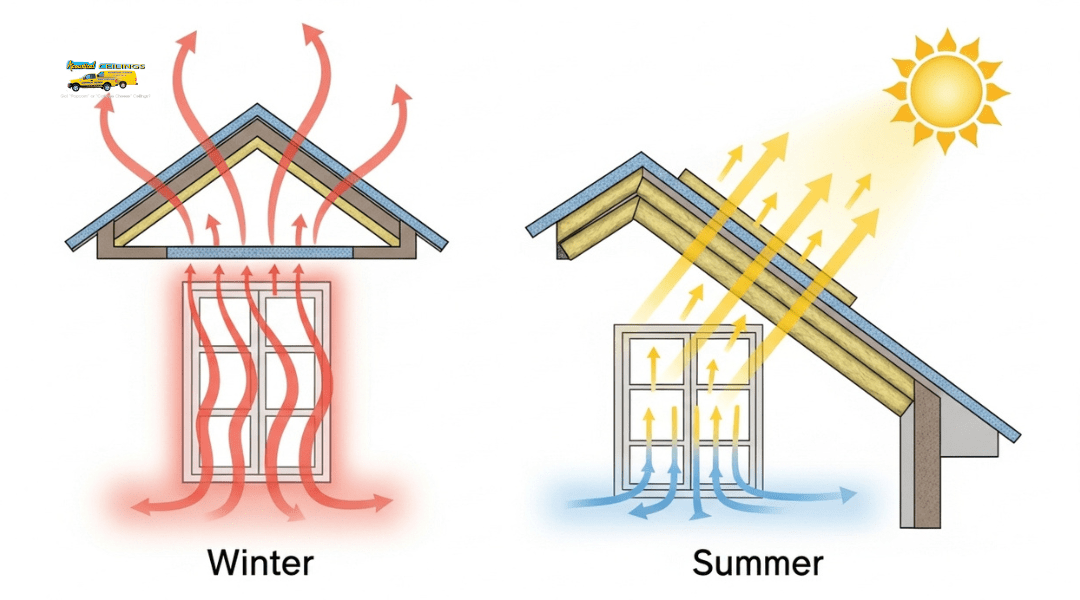
In summer, the roof absorbs heat from the sun, and without proper insulation, that heat moves into your living areas. Insulation acts as a barrier, slowing this transfer and keeping rooms cooler.
Key benefits of ceiling insulation include:
- Lower heating and cooling costs
- Reduced strain on HVAC systems
- More stable indoor temperatures
- Less draft and fewer hot or cold spots
By maintaining better thermal control, you not only save money but also extend the life of your heating and cooling equipment.
Why Rancho Cucamonga Homeowners Need Proper Insulation
Rancho Cucamonga experiences warm summers and cooler winter nights, making insulation especially important. Without it, your home can quickly overheat in July and lose warmth in January, leading to higher monthly bills.
Local homes often feature attics or cathedral ceilings, both of which require careful insulation to prevent energy loss. If insulation levels are too low, you may notice uneven room temperatures or a constant need to adjust the thermostat.
Common signs you need more insulation:
- Ceilings feel warm in summer or cold in winter
- Energy bills rise despite no change in usage
- Drafts or temperature swings between rooms
Adding or upgrading insulation in your ceiling helps keep your home comfortable year-round while reducing unnecessary energy waste in Rancho Cucamonga’s varied climate.
How Ceiling Insulation Affects Energy Bills
Ceiling insulation directly influences how much heat transfers through your home’s roof. By slowing both heat loss and heat gain, it reduces energy consumption, lowers heating and cooling costs, and helps you maintain consistent indoor comfort without overworking your HVAC system.
Reducing Heat Loss in Winter
In colder months, warm air naturally rises and escapes through the ceiling if there is little or no insulation. This heat transfer forces your heating system to run longer, which increases your energy bills. Proper ceiling insulation acts as a barrier, keeping more warmth inside your living spaces.
The effectiveness of insulation is measured by its R-value, which indicates resistance to heat flow. Higher R-values in your attic or ceiling mean less heat escapes, and you spend less on heating. For many homes, R-30 to R-49 insulation is recommended in attic spaces.
By reducing heat loss, you can cut heating energy use by as much as 20–35% depending on your home’s design and climate. This translates to noticeable savings on winter utility bills while improving comfort in every room.
Keeping Homes Cooler in Summer
During summer, the sun heats your roof, and without insulation, that heat radiates into your home. This raises indoor temperatures and drives up cooling costs as your air conditioner works harder to maintain comfort.
Ceiling insulation slows this upward heat transfer, preventing hot attic air from seeping into your rooms. Materials like fiberglass batts, blown-in cellulose, or spray foam all reduce unwanted heat gain.
By keeping indoor spaces cooler naturally, you rely less on constant air conditioning. This not only lowers monthly energy bills but also helps reduce wear on your cooling system. In hot climates, insulating the ceiling can reduce cooling energy use by 25–35%.
Lowering Dependence on HVAC Systems
When insulation reduces both winter heat loss and summer heat gain, your HVAC system cycles less often. This lowers energy consumption, extends equipment lifespan, and minimizes the need for frequent maintenance.
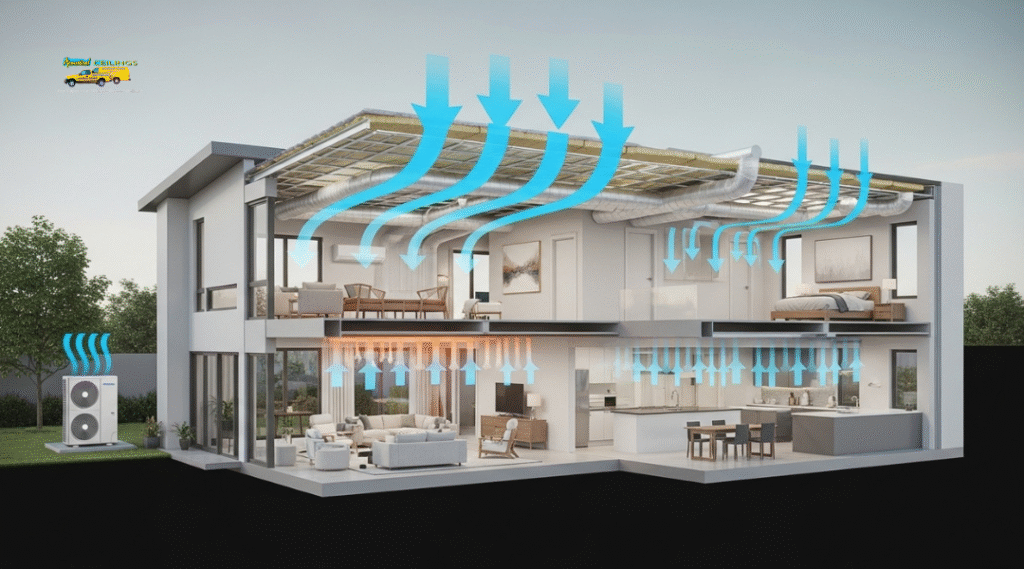
Less strain on your heating and cooling equipment also means more consistent indoor temperatures. You avoid the wide swings between hot and cold that often occur in poorly insulated homes.
Over time, the reduced workload on your HVAC system leads to measurable energy savings. With less energy wasted, your monthly bills stay lower, and your home remains comfortable without relying heavily on mechanical heating or cooling.
Comfort Benefits of Proper Ceiling Insulation
Proper ceiling insulation helps stabilize indoor conditions by reducing heat transfer, limiting energy waste, and improving comfort throughout the year. It also minimizes air leaks that contribute to uneven temperatures, drafts, and poor indoor air quality.
Maintaining Even Indoor Temperatures
When your ceiling is well-insulated, heat moves more slowly between your living space and the attic. This keeps your rooms warmer in the winter and cooler in the summer without overworking your HVAC system.
An insulated barrier reduces temperature swings caused by outdoor weather. Instead of experiencing sharp changes when the sun heats the roof or when nighttime temperatures drop, you maintain steadier conditions indoors.
By controlling attic temperature, insulation also protects against heat buildup that can radiate downward into your home. This consistency helps you avoid constantly adjusting thermostats and improves overall comfort in every season.
Reducing Drafts and Hot/Cold Spots
Drafts often result from gaps around ceiling penetrations, such as light fixtures or whole house fans. Without proper sealing and insulation, heated or cooled air escapes into the attic, creating uncomfortable spots in different rooms.
Insulation combined with air sealing reduces these leaks. You feel fewer drafts near vents, ceiling edges, or stairwells, which makes each space more usable year-round.
Hot and cold spots become less noticeable when insulation prevents uneven air movement. For example, bedrooms on the upper floor stay closer in temperature to those downstairs, so you don’t need extra fans or space heaters to stay comfortable.
Improved Indoor Air Quality and Noise Control
Air leakage through ceilings often carries dust, insulation fibers, and attic pollutants into your living areas. By sealing and insulating properly, you reduce the movement of these particles and improve the air you breathe.
Insulation also helps control moisture migration. A tighter ceiling limits humid air from entering or escaping, which reduces the risk of condensation and mold growth.
In addition to thermal benefits, insulation provides sound dampening. A well-insulated ceiling blocks noise from outside sources like traffic or rain and reduces sound transfer between floors, giving you a quieter and more comfortable indoor environment.
Types of Ceiling Insulation to Consider
Different insulation materials provide varying levels of thermal resistance, sound control, and installation needs. The right choice depends on your ceiling structure, budget, and the level of energy efficiency you want to achieve.
Batt and Roll Insulation
Batt and roll insulation, often made from fiberglass batts or mineral wool, is one of the most common options for ceilings. You can install it between joists or rafters, making it a practical choice for unfinished spaces.
This type of insulation comes in pre-cut panels or long rolls. It typically offers an R-value between R-2.9 and R-3.8 per inch, depending on the material. Higher R-values provide better thermal resistance, which helps reduce heat transfer through your ceiling.
You’ll find batt insulation relatively easy to install if the framing is standard and unobstructed. However, gaps around pipes, wiring, or irregular framing can reduce effectiveness. Properly fitting each piece is critical to avoid air leaks.
Batt insulation works well when you want a straightforward installation and a balance of cost and performance. It also provides a modest sound barrier, which can improve comfort in multi-level homes.
Blown-In or Loose-Fill Insulation
Blown-in insulation uses loose fibers, such as cellulose, fiberglass, or mineral wool, that are applied with a blowing machine. This method is effective for covering irregular or hard-to-reach areas, such as attic ceilings with uneven joist spacing.
The material settles into gaps and crevices, creating a continuous thermal barrier. Depending on the material, the R-value usually ranges from R-2.2 to R-3.8 per inch. Cellulose tends to provide higher R-values per inch compared to fiberglass.
Blown-in insulation is often chosen for retrofitting existing ceilings because it can be added without removing drywall. It’s also useful for topping up existing insulation if your current levels fall below recommended standards.
While installation requires specialized equipment, the result is consistent coverage and improved energy efficiency. This option is especially practical if you want to reduce drafts and minimize heat loss in older homes.
Spray Foam Options for Energy Efficiency
Spray foam insulation expands after application, sealing gaps and cracks that would otherwise allow air leakage. It comes in two main types: open-cell and closed-cell spray foam.
Closed-cell spray foam provides a higher R-value, often around R-6 to R-7 per inch, and also acts as a moisture barrier. Open-cell foam is less dense, with R-values closer to R-3.5 per inch, but it offers better sound absorption.
Because spray foam creates both an insulation layer and an air seal, it can significantly improve energy efficiency. It’s especially effective in ceilings where air infiltration is a concern.
Installation requires professional equipment and training, making it less suited for DIY projects. However, the long-term performance and ability to reduce heating and cooling costs often justify the higher upfront expense.
Spray foam also strengthens the structure of the ceiling by adding rigidity, particularly with closed-cell types. This makes it a durable choice when you want both insulation and a strong thermal barrier.
Common Mistakes Homeowners Make with Insulation
Small errors in insulation often lead to higher energy bills, reduced comfort, and even long-term damage to your home. Paying attention to material choice, installation technique, and building conditions helps you avoid costly inefficiencies.
Ignoring Gaps and Air Leaks
Even high-quality insulation fails if air leaks remain unsealed. Gaps around recessed lighting, attic hatches, ductwork, or wall penetrations allow conditioned air to escape, forcing your HVAC system to work harder.
You should always pair insulation with proper air sealing. Use caulk or expanding foam around small cracks, and weatherstripping around larger openings. This prevents drafts and helps insulation perform at its rated efficiency.
Unchecked leaks can also raise fire safety concerns. For example, insulation placed too close to unprotected light fixtures or chimneys creates a hazard. Installing insulation baffles and maintaining required clearances protects both your home and your energy efficiency.
Using the Wrong R-Value for the Climate
Insulation effectiveness is measured by its R-value, which indicates resistance to heat flow. Choosing the wrong level for your region leads to wasted money and poor comfort control.
In warmer climates, a lower R-value may be sufficient, while colder areas like mountain regions require higher ratings. Rancho Cucamonga, for example, benefits from attic insulation in the R-30 to R-60 range depending on your home’s design.
If you install insulation below recommended levels, your home loses heat in winter and gains heat in summer. On the other hand, overspending on insulation with an unnecessarily high R-value provides little added benefit. Matching the product to your climate zone ensures the best return on investment.
Overlooking Moisture Barriers and Ventilation
Moisture is one of the most common threats to insulation performance. Without a vapor barrier, warm indoor air can condense inside the insulation, reducing its effectiveness and leading to mold growth.
You should also maintain proper attic ventilation. Soffit and ridge vents allow moisture to escape while keeping insulation dry. A balanced system prevents ice dams in winter and reduces heat buildup in summer.
Ignoring these details can shorten the lifespan of your insulation and create indoor air quality issues. In some cases, trapped moisture also increases fire risks by degrading electrical components in the attic. Proper barriers and airflow protect both your insulation and your home.
Professional vs. DIY Ceiling Insulation
When deciding how to insulate your ceiling, you need to weigh the quality of the installation, the safety requirements, and the long-term financial impact. The choice often comes down to whether you want to handle the work yourself or hire a trained drywall and insulation contractor.
Why Professional Installation Ensures Better Results
A professional installer knows how to fit insulation batts or spray foam without leaving gaps, compressing materials, or missing hard-to-reach areas. Even small mistakes in coverage can reduce the insulation’s effectiveness and increase your energy bills.
You also benefit from product knowledge. Contractors can recommend the right R-Value for your climate, whether that’s R4.0 for warmer areas or R5.0–R6.0 for cooler regions. Choosing the wrong product can result in wasted money and less comfort.
Professionals also bring the right tools. Instead of improvising with a utility knife and stick, they use specialized equipment to work faster and safer. This efficiency means less disruption to your home and more consistent results.
Safety and Code Compliance Considerations
Working in a ceiling cavity exposes you to dust, fiberglass particles, and extreme heat. Without protective gear such as gloves, masks, and long sleeves, you risk irritation or injury. Professionals already follow these safety practices and know how to avoid hazards like electrical wiring and ventilation obstructions.
Building codes in California require insulation to meet specific fire safety and energy efficiency standards. A licensed contractor in Rancho Cucamonga ensures compliance by leaving proper clearances around recessed lighting, ducts, and exhaust fans.
If you install insulation yourself and fail to meet local building codes, you may run into issues during inspections, renovations, or property sales. Hiring a contractor eliminates this risk because the work is documented and code-approved.
Long-Term Savings of Hiring a Drywall and Insulation Expert
While DIY can save on upfront labor, improper installation often leads to higher utility costs over time. Gaps, compression, or poorly chosen materials reduce insulation performance and force your heating and cooling systems to work harder.
Hiring a drywall and insulation contractor means you get a job done correctly the first time. This avoids costly rework and maximizes the lifespan of the insulation.
A contractor can also combine drywall finishing with insulation upgrades. This integrated approach reduces labor overlap, ensures a cleaner finish, and improves both energy efficiency and interior comfort. Over the years, the energy savings often outweigh the initial installation cost.
Why Choose Acoustical Ceilings for Insulation in Rancho Cucamonga
When you select an insulation contractor, you want a team that understands both building performance and comfort. You also benefit from working with professionals who know local codes, climate conditions, and energy efficiency standards.
Expertise in Drywall, Ceilings, and Energy-Efficient Solutions
You work with a contractor who specializes in drywall and acoustic ceilings, giving you a single point of contact for both structural and insulation needs. This reduces coordination issues and ensures consistent quality across your project.
Acoustical Ceilings applies materials that not only reduce sound transfer but also improve thermal insulation. By combining drywall installation with acoustic ceiling systems, you achieve better indoor comfort while lowering heating and cooling costs.
The team uses proven installation methods that limit air leaks and thermal bridging. This attention to detail helps your home or business maintain stable indoor temperatures, which directly reduces energy waste.
Key advantages include:
- Integrated drywall and ceiling expertise
- Energy-efficient insulation methods
- Reduced sound transfer and drafts
Local Knowledge of Climate and Building Codes
Rancho Cucamonga experiences hot summers and mild winters, making insulation performance crucial for year-round comfort. You need materials and techniques that address both heat gain in summer and heat loss in cooler months.
Acoustical Ceilings understands how local weather patterns affect energy use. By tailoring insulation thickness and placement, they help you avoid overuse of air conditioning or heating.
Building codes in San Bernardino County require compliance with specific energy standards. Working with a local insulation contractor ensures your project meets Title 24 energy efficiency requirements in California. This protects you from compliance issues and helps you qualify for potential energy rebates.
Trusted Service Across San Bernardino County
You benefit from a contractor with experience across residential, commercial, and industrial projects in the county. This broad service record shows consistent results and reliability.
Acoustical Ceilings has built trust by completing projects on time and within budget. Their focus on clear communication helps you stay informed about material options, costs, and installation timelines.
As a local insulation contractor, they are accessible for follow-up service and maintenance. You can rely on their ongoing support, whether you need additional upgrades or adjustments to improve efficiency.
Service strengths:
- Wide project experience in San Bernardino County
- Consistent track record of timely completion
- Local support for long-term performance

